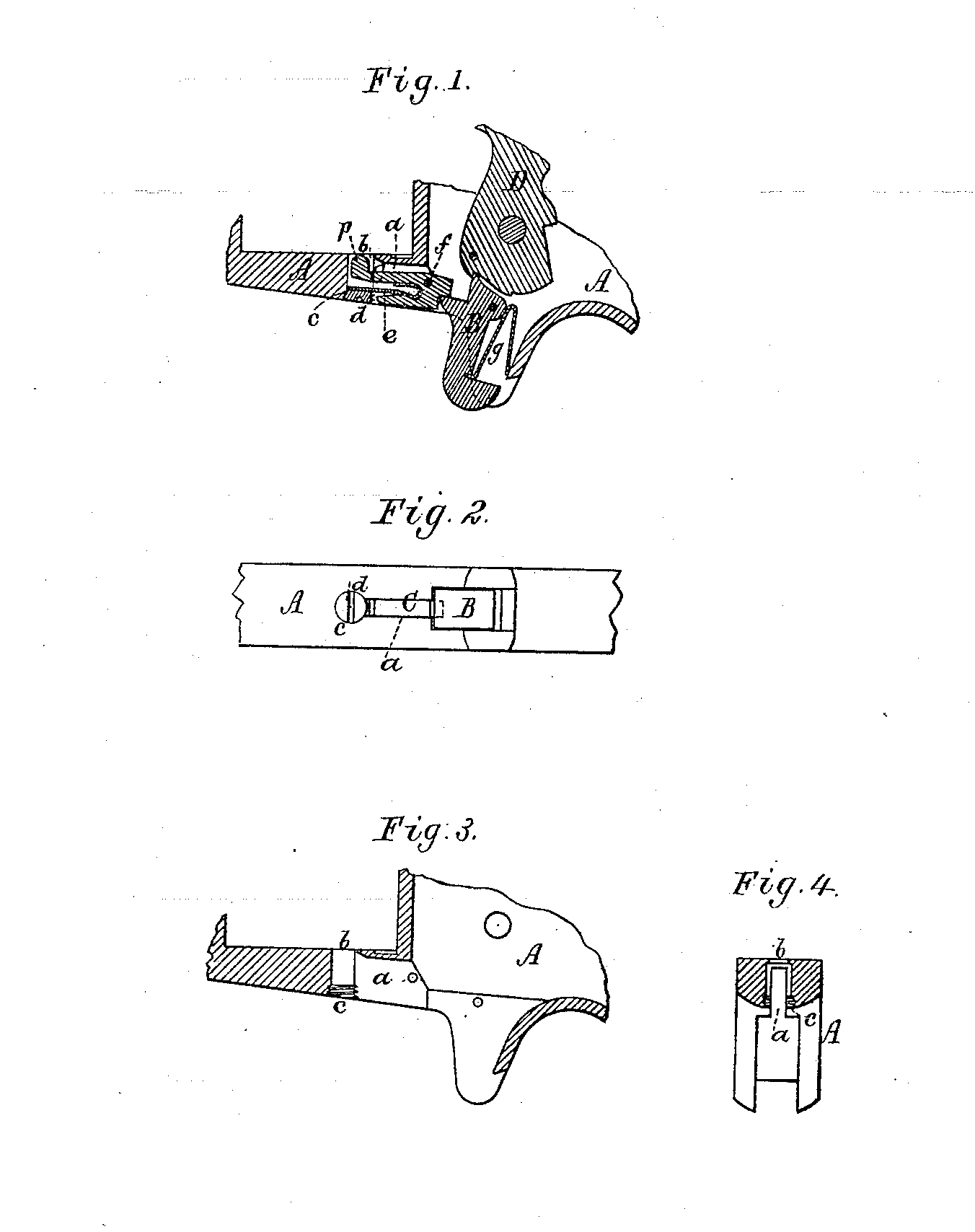US 268489
UNITED STATES PATENT OFFICE.
FREEMAN W. HOOD, OF NORWICH, CONNECTICUT.
REVOLVNG FIRE-ARM.
SPECIFICATION forming part of Letters Patent No. 268,489, dated December 5, 1882.
Application filed September 25, 1882. (No model.)
To all whom it may concern:
Be it known that I, Freeman W. Hood, of Norwich, in the county of New London, of the State of Connecticut, have invented a new and useful Improvement in Fire-Arms, termed “Revolvers;” and I do hereby declare the same to be described in the following specification and represented in the accompanying drawings, of which—
Figure I is a longitudinal and Fig.2 an under side view of the parts of a revolver to which my invention appertains, the nature of said invention being duly set forth in the claim hereinafter presented. The remaining figures, 3 and 4, are hereinafter explained.
Such invention is for the purpose of applying to advantage to the stock of the revolver, pistol, or fire-arm, and sustaining therein, the catch or latch of the rotary “charge-cylinder,” as usually termed. To this end I form longitudinally within the bottom of the stock A, and just in advance of the trigger B, a narrow recess or chamber, a, open or having its mouth at its lower part, and an opening, b, leading upward out of it (the said recess or chamber) at the for ward part of its top. This recess or chamber is shown particularly in Figs. 3 and 4, (the first of said figures being a lengthwise section of it and the part of the stock in which it is situated, while the second is a transverse section thereof.) At the frontend of the said recess is a screw-threaded bole, c, to receive a headed screw, d, whose diameter is longer than the width of the recess. On removal of the screw d from the threaded hole c the lever-latch C, provided with a spring, e, arranged in it as represented in Fig. 1, can readily be inserted within the recess, and with the catch part p of the said latch within the opening b, after which the fulcrum-pin f of the latch can be inserted into the stock and through the latch. The screw d, being next screwed into the hole c, serves as an abutment for the free arm of the spring to rest upon. The latch is represented in the position it takes when the hammer D is at “half-cock.” While the hammer is being moved to “full-cock” the charge-cylinder will be partially revolved and the trigger be moved to enable the spring e to force the latch C upward into one of the locking-recesses of the cylinder. On the hammer being drawn backward to half-cock, the actuating-spring g of the trigger B will move the trigger so as to cause it to move the latch on its fulcrum out of engagement with the cylinder, the spring e being by such movement of the latch contracted, in order for it by its expansive power to force the latch into engagement with the cylinder when such may next be required.
Before my invention it has been customary to have the recess open along its to) and closed at bottom, whereby it became a matter often of much inconvenience or difficulty, as well in making such recess as in inserting the latch into it or extracting it from it. With my improvement these difficulties are avoided or very materially lessened.
I claim—
In a revolver, pistol, or fire-arm, the stock provided with the screw-threaded hole c, and with the latch-chamber a, open at bottom and at top, and opening into such hole c, substantially as set forth, in combination with the screw d, screwed into such hole, and with the charge-cylinder latch C and its spring e, arranged within such chamber, and with respect to the trigger and the said screw, essentially as represented.
F. W. HOOD.
Witnesses:
R. H. Eddy,
S. N. Piper.

